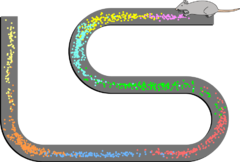Spatial firing patterns of 8 place cells recorded from the hippocampal CA1 layer of a rat's brain. Dots indicate positions (place fields) where action potentials were recorded as the rat moved back and forth along a track, with color indicating which neuron emitted that action potential.
Action potentials (one in the box) recorded from a single place cell during a burst of activity
An EEG theta wave
Phase precession is a neurophysiological process in which the time of firing of action potentials by individual neurons occurs progressively earlier in relation to the phase of the local field potential oscillation with each successive cycle. In place cells, a type of neuron found in the hippocampal region of the brain, phase precession is believed to play a major role in the neural coding of information. John O'Keefe, who later shared the 2014 Nobel Prize in Physiology or Medicine for his discovery that place cells help form a "map" of the body's position in space, co-discovered phase precession with Michael Recce in 1993.[1][2]
- ^ O'Keefe J, Recce ML (July 1993). "Phase relationship between hippocampal place units and the EEG theta rhythm". Hippocampus. 3 (3): 317–30. doi:10.1002/hipo.450030307. PMID 8353611. S2CID 6539236.
- ^ "The Nobel Prize in Physiology or Medicine 2014: John O'Keefe – Biographical". Nobelprize.org. Archived from the original on 29 September 2017. Retrieved 27 January 2018.



